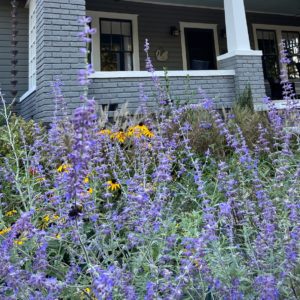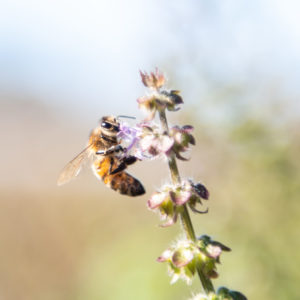Turning my front yard into a home for diverse species helps me grow and thrive, too.
When I read about a Maryland couple who turned a uniform lawn into a lush, pollinator garden, I was fascinated – and surprised. My own experience turning a traditional lawn into a biodiverse plant haven has been very different. My new pollinator lawn spurs conversations. It creates a community of species that invites human attention. Even my most skeptical neighbors chat with us now about the garden that thrives in front of our house, and all the creatures that call it home. That Maryland couple’s garden inspired a new state law that protects biodiversity. I’d like to think mine is changing attitudes too – starting with my own.
Maintaining a uniform lawn had become increasingly difficult.
As newer and bigger houses began taking over our quiet street, our postcard-perfect grassy lawn was becoming harder to maintain. The large pin oaks started coming down at an alarming rate as they succumbed to age, disease, and development. Professional lawn care and mosquito control companies became regular visitors to our neighborhood. The fireflies, dragonflies, bumble bees and butterflies grew scarce. Controlled lawn management was creating a fragile system that could not withstand or recover from heavy rains, temporary droughts, and seasonal temperature changes.

I had been cultivating consistency, but not beauty.
As I spent my working days at Juneberry Ridge discussing polyculture ecosystems, I started to see my own front yard in a different light. It was a little piece of unsustainable monoculture. In order to keep one type of plant locked into one, static state, I was driving out or killing off anything else that might grow there. Thinking of all the time I’d spent trying to keep out clover, little onion plants, or creeping wild strawberries that tried to take root, I realized that “caring” for my lawn was mostly about destroying healthy plants. Nature wanted to grow here. I had been trying to keep it out.
I set out to make this a home for the native plants that want to be there.
This meant changing the soil and changing my thinking. Pulling out all the fescue, tilling the dirt, adding a lot of compost, shredded cardboard, and leaves, then letting it all percolate – that took care of the first part. For the second part, I turned to my friend and neighbor Elaine – the one who had the abundant yard that didn’t fit in with the rest. I wanted to learn about the indigenous plants she grew, but I was still tentative. “I’ll listen to her ideas, but I’m not going to let my yard become completely wild like hers,” I thought to myself (surprise: my yard today is wonderfully wild, and I love its surprising harmony). With her help, I started to experiment. She gave me plants, helped me put them in place and taught me how to care for them. Her advice, along with insights I read in books and tips from colleagues at Juneberry Ridge, all helped me choose the variety I wanted for my new yard.
An edible landscape started to take shape.
To frame my tiny 30’ x 40’ yard, and add some height within it, I planted several small trees. A hawthorn and a Kousa dogwood attract pollinators and birds needing early spring nectar and a safe place to build their nests. A Fortunes tea olive next to the porch adds fragrance. A Japanese maple provides shade where all manner of critters can hide. Two varieties of redbud, the Ruby Falls and the green-yellow Cascade Falls bloom beautifully in their healthy canopies. Our bee balm, lavender, and edible Echinacea magnus attracted bees and humming birds too. We added alpine strawberry plants, blueberry bushes, nasturtiums, and herbs such as rosemary and sage that all came from Juneberry Ridge – as did our juneberry bush, of course. We delight most of all in the variety of groundcovers: mozus, creeping phlox, and ajuga. Each surprises with tiny blooms staged throughout the spring and summer.

Sparkling Saphire Baptisia: Seeing the beauty of maturity.
One of my most beloved plants in the yard is the Sparkling Saphire baptisia. It is just unbelievably gorgeous, with a deep blue color that can look purple, depending on the light. It has always thrived in our mid-Atlantic climate, and in the past Native Americans and European settlers used its flowers to make blue dyes. Today, many homeowners don’t like it because it can grow out of control quickly, and not everyone appreciates the look of the large, black, husky seed pod that it produces. But I enjoy its spiky architectural form and how it serves as a focal point in spring and handsome space filler in summer.
Most importantly, I let the yard grow and mature to seed.
No more keeping it stuck in a single phase of its life. I have grown up, matured, and transformed with time. Nature needs to do that too. So I let go of my need to control it and opened myself to the adventure of seeing how biodiversity creates resilience. Everything is healthy in my yard because there is so much variety. The plants get so much of what they need from each other, and I get more than I expected from them.
Like most of my neighbors, I was a little conflicted at first.
But I started to fall in love with the new yard when I saw all the living things that felt at home in it. The first thrill was seeing the fireflies return. Bees and dragonflies soon followed. Spring Azure butterflies came that first April, and then two endangered species in late summer and fall: Karner Blue and Monarchs – all fluttering about. Chipmunks and moles have found their places – and so has the Barred owl that perches on the redbud watching them. The birds that flock to our feeder sprinkle Sunflower seeds on the ground beneath it. But the creatures that delight me most are the human ones. The kids in my neighborhood come into my yard to see the wonders of nature. They thrill to find interesting leaves and see how they change. They get excited about bugs and worms and flowers and seed pods that rattle.

The bees showed us the boundary.
My neighbors and I were not the only ones attuned to the difference between our lawns. We started finding dead bees in the driveway that divides our property. Bees can range as far as 2 miles in search of protein-rich pollen, and my garden had become a home for a large population of these enterprising workers. When they crossed the driveway in their explorations, they fell victim to the chemical fertilizers and pesticides that were necessary to keep the neighboring yard looking its best.
I am a part of this wonderful yard too.
For as much as I loved admiring the “perfect” green grassy lawn I’d had for years, I realize now that I almost never spent time in it. It was something to look at, to pass through, and often to worry about or obsess over. It was not something to live in, to rejoice in. This new yard fulfills me and rewards my time and attention. I walk out into its twisting paths to check on the plants and to harvest herbs, berries, and flowers. Now, when guests come to my house, we spend time in the garden; they always want to explore and ask questions before we get to the front door.
We are all part of nature.
I’ll have to be a little vulnerable and admit that in the midst of planning this transformation, I neglected to snap an excellent before and after photo. For those with strong imaginations, you might see my lawn (photo below), and then look outside your own window and dream up a pollinator garden of your own. As all gardens always will be, mine is a work in progress, but for my husband and I, along with my neighbors, and especially our cat, we couldn’t be happier with the result.
For me, letting go of my need to constrict and control nature has been a liberating experience. At Juneberry, I’m passionate about our work to change the way the world grows, and now I get to see that work in living progress at home. My yard is not all that is growing. I am too.




